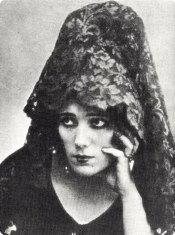Raquel Meller | home 
Back to BIOGRAPHY
BIOGRAPHY 2
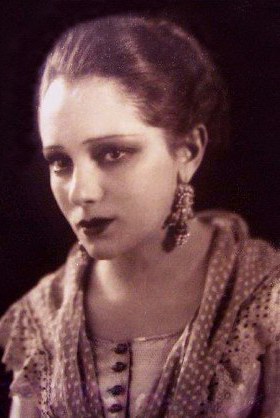 Raquel, a rare beauty with a captivating personality.
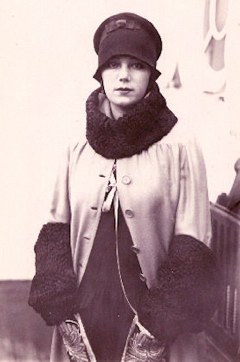 Aboard the SS Leviathan bound for New York
|
Raquel’s triumph at New York's Empire shook the entire country. On opening night, bankers, executives, assorted millionaires, and the cream of society were there and fell immediately to the Meller spell. Time magazine featured her on the cover of their April 26, 1926 edition and a New York Times theater critic described her as "a sorcerer." After a couple of sold out weeks in the Big Apple, the time came to board the private railroad cars that would get Meller to Philadelphia, Chicago, Boston, Baltimore, and Los Angeles in a tour that eventually lasted several months.
Everywhere she was received as royalty but her arrival in L.A. was particularly memorable since she was embraced by the film colony. Raquel hobnobbed with the greatest stars and technicians in the movie capital of the world and was seen with Pola Negri, Gloria Swanson, Harold Lloyd, Mary Pickford, and husband Douglas Fairbanks. On opening night most of them were there along with longtime admirers Charlie Chaplin, Cecil B. DeMille, and Rudolph Valentino. Watching Raquel perform, Mr. DeMille made his now famous observation, "She is the mask of tragedy!"
Chaplin invited her to spend some time at his studio and offered to pay her twice what she was making in films if she agreed to star with him as Joséphine de Beauharnais in a production he was planning based on the life of Napoleon Bonaparte. It is not known why Raquel didn't accept the proposal and the film was never made. Whatever the reason, the Hollywood genius was forever impressed by Raquel’s image and her music, and the two artists remained lifelong friends.
As it happened, Raquel ended up making history in the American film industry by starring in an early "talkie" in which she sang four of her greatest hits. The short film was done sometime in 1926 at the Fox Movietone studios in New York but was not shown until 1927.
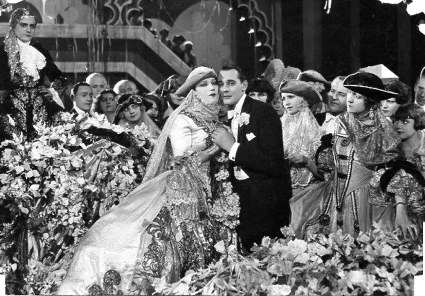 Raquel in the 1928 film "La Venenosa"
|
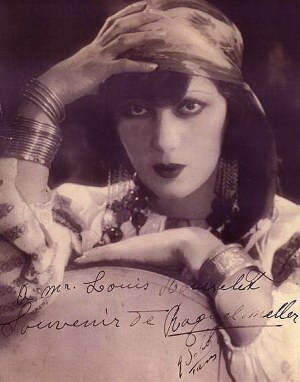 Raquel with her exotic and romantic image
conquered the United States
 Chaplin & Meller: mutual admiration
|
Just when the American tour seemed to be extending itself all hell broke loose. In Baltimore Raquel suddenly exploded against Ray Goetz and decided to cancel the tour. Before anybody realized what was happening, Meller and her entourage, chefs and all, were back in Paris.
In 1928 she shone, brighter than ever, in the musical revue La Luxe de Paris and a year later her status as "the first lady of song" was confirmed in another musical extravaganza titled Paris-Madrid. However Meller continued taking her unreachable image to new heights and not even Chaplin could move her. In 1930 he tried to fulfill his old dream of working with Raquel by offering her the part of the blind girl in his film City Lights but by then she was working towards a dream of her own. She wanted fiercely to be respected as a serious stage actress, and was preparing for that goal by courting the most distinguished French play writers of the day. She said no again to Chaplin and yes to Maurice Rostand, whose credits included writing La Gloire for Sarah Bernhardt. Chaplin went ahead with City Lights substituting Raquel with Virginia Cherrill but he kept La Violetera as the blind girl's theme. It is still debated why Chaplin took credit in the film for writing La Violetera but he was promptly sued in a Paris court by José Padilla and was ordered to compensate the Spanish composer.
|
|
TIME MOVES ON
In early 1932 Raquel Meller made her stage acting debut in the play Une Jeune Fille Espagnole (A Young Spanish Girl) written for her by Rostand. It is not known if it was the author's idea that the leading character, named Pomposa, becomes a singer midway through the proceedings allowing Raquel to sing four songs. Wherever the idea came from, the songs ended up being the icing on the cake. Although there's no way to confirm it, Raquel and her followers claimed that the play had over a hundred performances. Raquel had every right to be proud of her accomplishments but, more than ever, her uncontrolled ego began to play tricks on her objectivity. She now saw herself as "the star", both unique and irreplaceable. She rejected all other performers as, either imitators or no talent bums, and the notion was validated by the hard core fans who hung around her.
Almost immediately she filmed the sound version of "Violettes impériales" in which she acted and sang. The "talkies" were now the latest thing in entertainment and she received an incredible amount of publicity for this production. She was certainly basking in all the attention and did not notice that the times were changing and that music was beginning to evolve. She also ignored the fact that she was now 44 years old and though still a very attractive woman, the freshness of youth was passing rapidly. On the strength of her name and a large fan base she would go on for another decade but she was not adding new admirers to the equation. Suddenly, it seemed like the most generous offers of work were now coming from Spain and in 1936 she accepted the starring role in the film "Lola Triana" to be shot in Barcelona with exteriors in Seville.
Back in her homeland Raquel found a totally different environment. Monarchy had been overthrown since 1931 by the Second Republic and the government was being influenced by communism from abroad. Persecution of the Church was brutal and the artist, who was professing to be devoutly Catholic, felt uncomfortable. The fact that they had replaced the bicolored traditional Spanish flag with a new tri-colored banner, did not sit well with Raquel either.
|
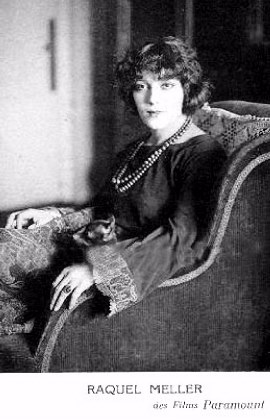 |
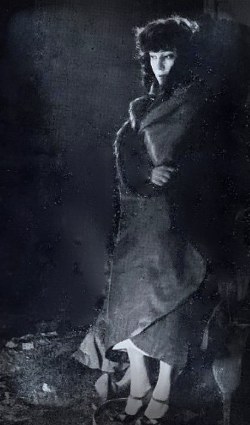 Raquel in an intriguing portrait.
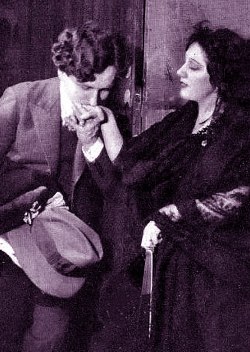 Maurice Rostand kisses Raquel´s hand
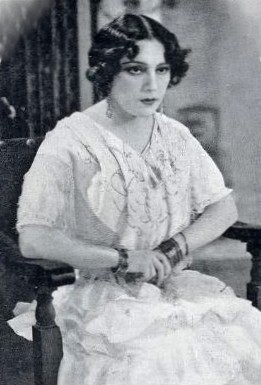 Raquel in a pensive mood
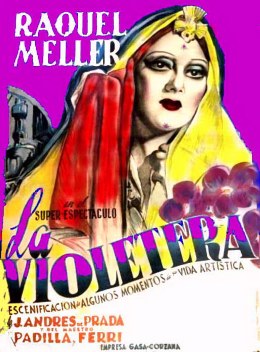 A new musical for Raquel.
|
Meanwhile stage actress Margarita Xirgu had embraced the new regime and was the darling of the government-controlled press. Maestro Jacinto Guerrero had the not so bright idea to introduced the two artists at a social function and a public relations disaster developed. When Xirgu extended her hand to greet Raquel, the singer just turned around and ignored her. As she walked away, in a loud voice so that everybody could hear her, she exclaimed: "That woman stands for something I don't agree with so we are politically incompatible." The backlash was huge. The press sided with Xirgu and attacked Meller mercilessly. As usual Raquel ignored all the bad publicity and went on to work on the "Lola Triana" production. It is not known precisely how much filming was done but soon the project was halted and eventually canceled when the Spanish Civil War broke out. Horrified by the bloody conflict, Raquel retreated to her villa in Villefranche-sur-Mere and decided to wait out for better times. Soon she was back in Paris singing in the musical revue "Paris en joie" which somehow revalidated her superstar status in the City of Lights.
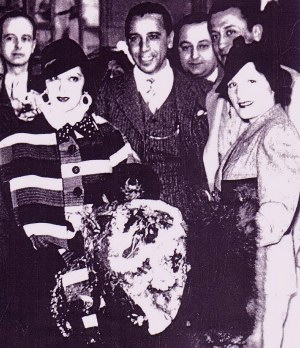 Libertad Lamarque (to the right) with the committee that welcomed
Raquel to Buenos Aires in 1937.
Next she accepted a contract to sing in Buenos Aires and her return to that city, although treated like a major event, had lukewarm results. Actress-singer Libertad Lamarque wrote in her 1988 autobiography that she was commissioned to head the reception committee that would greet Raquel at the harbor. Miss Lamarque was excited to meet Raquel whom she had always admired, but the meeting of the two stars ended on a sour note. Raquel, back to her old tricks, decided to mistreat Lamarque and the Argentine artist did not understand why she was on the receiving end of Raquel’s bitchiness. Somebody pointed out that she had the same hairdo, short with bangs over the forehead, that Raquel considered her own trade mark.
It could also have been that Lamarque was twenty years younger and at the top of her career but the incident clearly demonstrates that Meller had lost nothing of her panache for conflict.
By 1939 the war in Spain had been won by the loyalist forces of General Francisco Franco, with a little help from the fascist regimes of Germany and Italy. Though Raquel did not like the man, she was happy that the anti-Catholic Republicans were gone and the political atmosphere in her country had turned to the right. Soon there was no safe place in Europe with the outbreak of World War II except for Spain which became officially non-belligerent in the conflict. When the Nazis occupied France in 1940, Raquel ran out to Spain in a hurry. She was furiously against anti-Semitism since many of her friends were Jewish and, though she distrusted the Franco regime, she was forced by the circumstances to settle down in Barcelona.
At least the traditional Spanish flag had been restored and the Church was enjoying preferable treatment by the dictatorship.
It was precisely in the Church, that Raquel was able to marry French businessman Edmond Sayac, since her first husband Gómez Carrillo had died in 1927. All reports point at the union as "a marriage of convenience" but soon the couple adopted a boy whom they named Jordi Enric. This brings to mind daughter Elena who had been notably absent from her mother's life for many years. Rumors persisted that Elena, unable to develop a good relationship with her mother, had joined a religious order of strict closure in France. Jordi Enric was probably luckier and grew up mostly under the tutelage of his father in France, but after reaching adulthood he managed to achieve a warm kinship with his famous mother in Spain.
Raquel presented in Madrid the revue ¡Alló Hollywood! which was warmly received by audiences and a year later she opened in Barcelona with another lavish musical aptly titled "La Violetera." This did not mean that Raquel was back as the queen of entertainment. The place that she once held by herself, was now shared by other female singers, such as Imperio Argentina, Conchita Piquer, and Estrellita Castro.
Since the mid 1930s, a musical genre called copla had become the rage in Spain replacing the old cuplé. While the cuplé had French origins and an international flavor, the copla was strictly a product of Andalusia and was heavily influenced by Flamenco. The lyrics were mostly very dramatic and forceful requiring voices that were strong and heart-rendering. Raquel’s tiny, angelic sweet sound, could not compete in the current musical trend. In short by the 1940s both Raquel and the cuplé had become anachronistic.
|
TO HELL AND BACK
In 1945, the war, and past due taxes, stripped Raquel of her possessions in France, but she was far from being destitute, since she had the Barcelona property plus a considerable amount of jewelry, and valuable art. When work offers thinned out, she put on the attitude that she was too rich to care. Deep down she was utterly depressed as revealed in the letters she wrote to friends during long periods of inactivity. In one particular letter, she described her feelings as being in a dark bottomless pit without hope.
To be objective, it must be reiterated that, in spite of her ego and volatile temperament, Raquel was very generous and never failed to assist her relatives, and needy friends, especially during the harsh post war years. Many claimed to have been saved by her financial and moral support, remaining forever grateful to the artist. It is also a proven fact that during her long career she contributed her talents to numerous charity events in Spain, France, Belgium, United Kingdom, United States, and other countries. Among her most treasured possessions, she kept written acknowledgments from the King of Spain, the King of England, the King of Sweden, the French government, apostolic blessings from both Pope Pius XXI and Pope Pius XXII, and many other recognitions given to her through the years for her philanthropic activities.
Raquel was indeed very receptive to requests for help to worthy causes, and she was usually kind to her collaborators in show business. However, most female singers would never see the nice side of Meller. In her 1920 autobiography Raquel stated "my female comrades would probably laugh at what I have written in this book...if they only knew how to read."
|
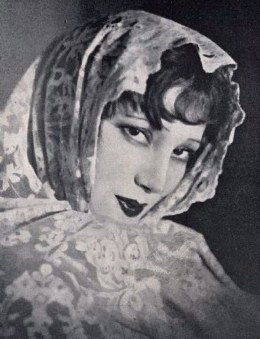 A famous Meller close up
|
In 1946 Raquel was featured in the stage musical Melodías del Danubio (Danube Melodies) produced by the popular Viennese company of Arthur Kaps and Franz Joham. Actually. the Austrian producers just wanted to add a well known name to the already established production, while Raquel thought, as usual, that she was the production. In any event, she was back performing in a fine theater surrounded by expensive sets and dressed in nice gowns. She failed to recognize that the public who came to see her, were venerable senior citizens who still remembered her. However, she was not impressing any of the young people who wandered in the theater by chance or by curiosity.
By 1950 Raquel was totally forgotten, ignored by the media, and unknown to the new generation. She spent her days at home reading, tending to her pets and being extremely distrustful of anybody who knocked at her door. Sometimes she was seen sitting at a nearby cafe having lunch or sipping on a cup of latté, but she avoided talking to anybody or even making eye contact. She was now over sixty and the years had been cruel to her appearance. Actually she looked older than her age, since she was no longer taking care of herself. No more beauty salons, no hair dyes, no fashionable hair styles, no make up; overweight and wearing a wardrobe that looked second hand and old fashioned, nobody could tell that this old lady had once been one of the world‘s most glamorous women. She lived frugally although she still had money left and could afford a less miserable lifestyle. It has been said that Raquel was now trying to live her Catholic faith by taking vows of humility and poverty. On certain days she rode a bus to the outskirts of the city to help at a leprosy ran by the Franciscans. It is possible that by then she was suffering the first symptoms of senility as her behavior was at times erratic.
Occasionally she was invited to perform a couple of songs in charity and community events along with other performers. She attended these social functions with the same demeanor as if it was 1920 all over again and she was back at the Olympia in Paris. Her son Jordi Enric, along with her sister Tina, and some old friends, were concerned about her progressive mental and physical deterioration but, true to character, she would not take any advice from anybody, and guarded her privacy zealously. Only when she began feeling out of breath, and had chest pains, she allowed to be taken to a cardiologist. Diagnosed with heart disease, Raquel was prescribed the proper treatment and from then on she would mention her illness to anybody who got close enough. I can't work anymore, she'd say dramatically,
I have heart trouble, you know?
|
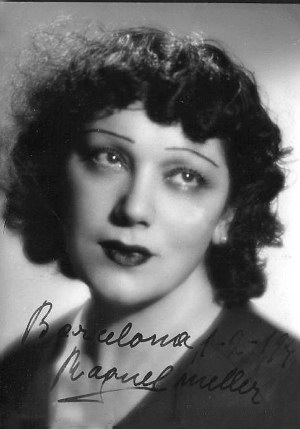 There is sadness in her beautiful eyes in this photo from the 1940s. Maybe she could see into the future...?
|
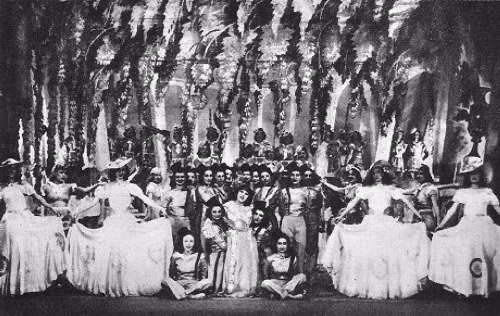 The grand finale of the stage production "La Violetera" (1941)
|
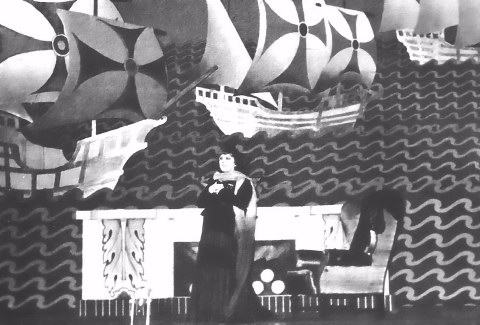 Raquel singing "The Three Caravels" in the "Vienna Bells" revue (1956)
|
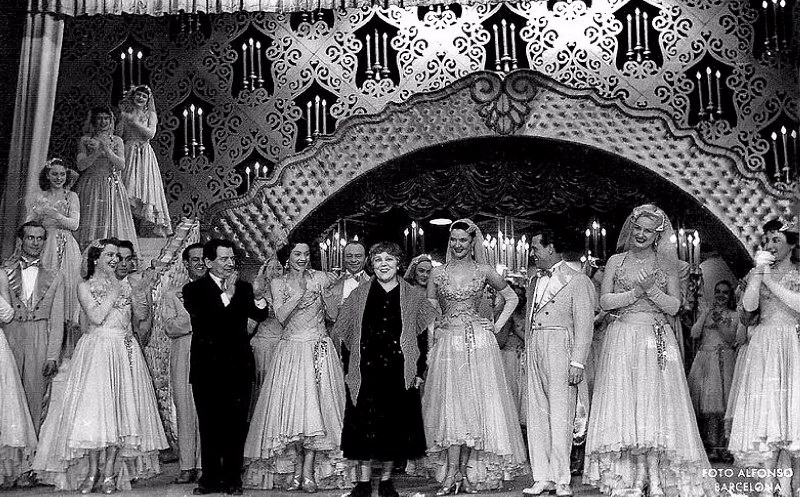 Raquel receives an ovation at the end of the musical revue "Vienna Bells" in Barcelona's Teatro Cómico 1956.
|
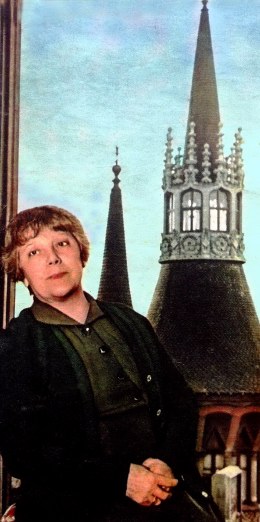 Raquel as featured in a 1957 magazine spread
|
In the mid 1950s, a strange phenomenon started when Radio Española, Spain’s public radio station, began broadcasting a program named "Aquellos tiempos del cuplé," a live nostalgia show recalling "those long ago cuplé times." Targeted to seniors, the format had a couple of grandparents recalling the first decades of the 20th century and the music that was popular then. Singing the songs, was a young lady named Lilián de Celis who was a music student at Madrid´s Conservatory. The program reached an audience that liked the format and soon Lilián was recording covers of the most famous cuplés, including some of Raquel Meller´s greatest hits. It is important to remember that the impact of the radio show was basically among senior citizens who were happy to reminiscence about the good old days. In spite of its success, the show didn't do anything to revive the careers of Raquel and the other original cuplé stars. Meller herself, decided to ignore both the show and this new singer who was launching a career singing "her songs."
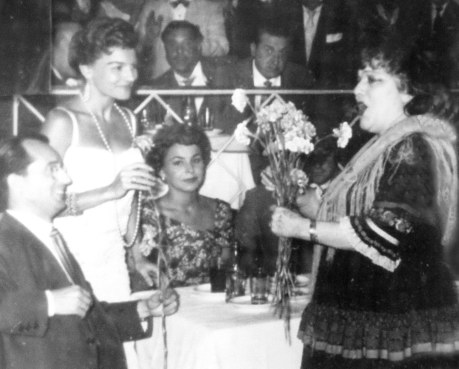 Raquel performing at a benefit gala with Lilián de Celis (standing) in attendance.
|
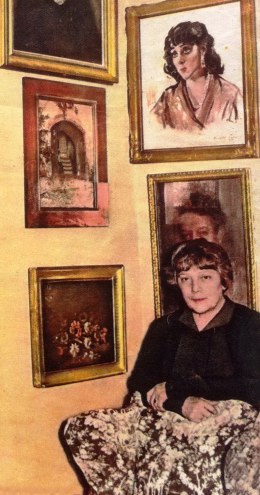 At her apartment surrounded by art and memories...
|
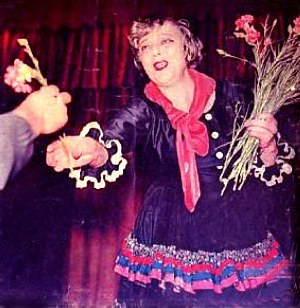 Raquel spreading her flowers for the last time.
|
However, in spite of her aloof attitude, it was all weighing heavily on Raquel and she felt betrayed and totally helpless. In 1956, writer Ramón Pujol, a personal friend, decided to come to her rescue. His idea was to write a Meller biography that would do some damage control and reclaim for the singer the place that she deserved in music. The book was written and published but ended up being a tedious literary absurdity with page after page of uncontrolled praises. Her old friends Kaps and Joham, from the Viennese theater troupe, had a much more practical idea. They invited Raquel to appear in their new musical revue "Campanas de Vienna" (Vienna Bells) another fine production in which the signer was presented with dignity and respect.
But while Raquel was happily working with the Viennese, another crisis was brewing. Film producer-director Juan de Orduña was preparing his own cuplé project probably inspired by the success of the radio show. The film would be titled "El último cuplé" (The last cuplé) and the script told the story of a forgotten cuplé star who recalls her days of glory in a long flashback. At the end, the character tries for a come back but has a heart attack on stage and dies. The project encountered all sort of financial difficulties since nobody wanted to invest on a film about cuplés and nobody believed in the actress that Orduña picked for the starring role. She was Sarita Montiel, who for some years had worked in Mexican films and lately had been vying for a Hollywood career. In spite of her photogenic beauty and achievements, she was not box office material inSpain and few knew she could sing.
"El último cuplé" was finished somehow and it opened at Madrid’s Rialto cinema taking advantage of a law requiring that a certain number of Spanish films be shown for each foreign film booked. Nobody expected what happened next. From opening night, the audiences fell in love with both the film and its star and word of mouth went out that something extraordinary was being shown at the Rialto. Soon there were long lines of people waiting for each showing and "El último cuplé" became a social phenomenon playing to full houses for almost a year. This is not the place to examine the extraordinary events that Montiel and Orduña´s film unleashed on the times since that, by itself, deserves a book. Suffice it to say that the cuplé became the rage of both young and old, male and female, rich or poor and everybody sang cuplés.
|
 |
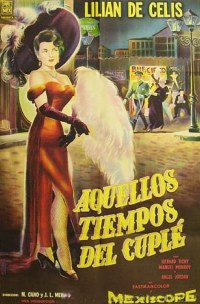 |
 |
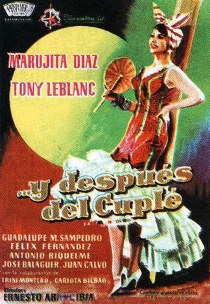 |
END OF THE ROAD
Raquel Meller took all the commotion as a personal insult and when the media came to her for a reaction she told them exactly how she felt. That woman is imitating me but she sounds like a drunken security guard. The press rejoiced at the emerging feud and gave Raquel plenty of space to voice her diatribes against Montiel, but the public just didn't care and disregarded it as the rumblings of a crazy old lady. However, all the publicity had brought Raquel’s name to the limelight and she was offered the opportunity to make a big come back at the Madrid Theater in the stage musical "Ha salido el Blanco y Negro" (Blanco y Negro magazine is out). Opening night was attended by great personalities of the cuplé era and lots of fans but Raquel’s presentation left a lot to be desired. It is unbelievable that she was allowed to go on wearing a tasteless wardrobe, misapplied make up and white hair that looked like it hadn't been combed in weeks. Writer Ángel Zúñiga, one of her most devoted biographers wrote: "She performed with a broken voice, bright-less eyes, clumsy movements and worst of all, a wardrobe that made her look like a grotesque buffoon from the early days of this century."
Reviews were, at best, lukewarm and the general public stayed away preferring to stand in line in a nearby cinema to watch
El último cuplé. Sarita was brought back from Hollywood in a hurry and given a multimillion dollar contract to make more films and records in Spain. Her next vehicle was, of course, La Violetera (1958) and when it premiered in Madrid the crowds stopped traffic on La Gran Vía boulevard. Both films played with similar success all over Spain, every country in Latin America and eventually all of Europe and the world.
|
Raquel’s show folded after a few tortuous performances and she had no choice but to retire for good. Meanwhile, not only Sarita but Lilián de Celis and every other female singer in Spain and Latin America were making a mint singing cuplés in films and records. All of Raquel’s bread and butter hits, El Relicario, La Violetera, Mala Entraña, Flor de té, Ven y Ven, etc. were now the rage, but few remembered the artist who had immortalized them. Knowing Raquel’s temperament, it is easy to understand why she became extremely bitter, feeling like everybody was destroying her legacy and making money on her back.
In 1961 Raquel made her first and only television appearance on RTVE singing a couple of songs including La Violetera. It was also her last public performance. That same year French film producers approached Raquel seeking her approval for a movie based on her life. She felt curious about the project and inquired who would be playing her. When the name Sara Montiel was mentioned, she reacted violently and refused to discuss the matter any further. The film with Montiel was finally produced in Spain under the title "La Reina del Chantecler" (1962) but the script was carefully doctored so that Raquel couldn't file a formal complaint. However, one of the main characters remained as a playboy journalist, suspiciously similar to Gómez Carrillo, and it also made references to the Raquel-Mata Hari legend.
Raquel’s last year in this world was uneventful and peaceful. She had become a recluse, an exile in her own country. Nobody was allowed in, not even family or close friends, unless prior arrangements were made by telephone. Her behavior was more erratic than ever but sometimes, if the weather allowed it, she would walk out of her enclave and do her own shopping. By her bedside, she had proudly on display the blessings of the Popes, and it is possible she did a lot of praying and meditation. Sometime in late June 1962, Raquel collapsed in her home and was rushed to the local Red Cross Hospital. It was a major stroke but they were able to save her and in the weeks that followed her condition improved.
At the hospital she was definitely given preferential treatment thanks to the good wishes of hospital president and main benefactress the Countess of Lacambra, and Mother Superior Mary of Aragon, from Raquel’s homeland, who was in charge of the nuns serving at the institution. There was one particular nurse who was especially kind to the patient and developed a great relationship with the ailing Raquel. Son Jordi Enric was a daily visitor and her mother made sure he knew about this nurse telling him that she was the kind of woman that would make a good wife for him.
|
 A French paparazzi caught Raquel out in a Barcelona boulevard doing some shopping.
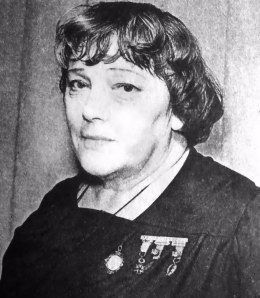 Raquel poses proudly with her medals.
|
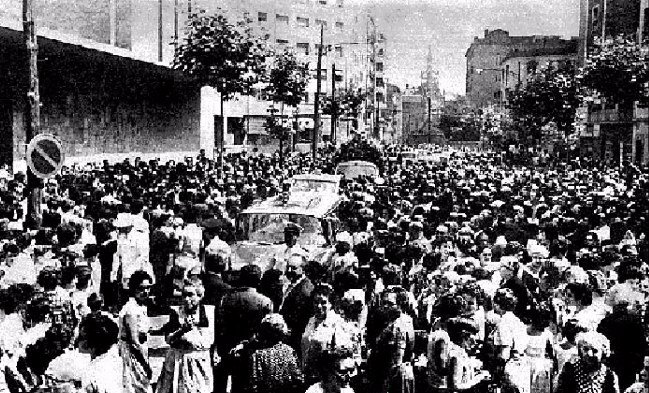 Raquel´s funeral procession in Barcelona
|
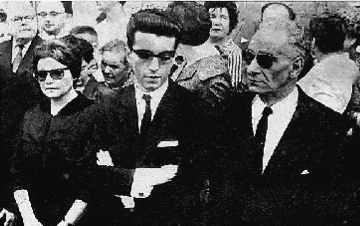 Daughter Elena Gómez Carrillo, son Jordi Enric Sayac and estranged husband Edmund Sayac at Raquel´s funeral.
|
It was reported that during Raquel’s convalescence, the hospital received daily over two hundred telephone calls from old friends and fans. The Countess, Mother Superior and the specialist in charge, Dr. Agustín Gómez, all rushed to Raquel’s side when the artist suffered an unexpected pulmonary embolism on the evening of July 25th, 1962. They were soon joined by son Jordi Enric and all kept a vigil through the night until the early morning hours of July 26th when Raquel Meller died quietly.
It was 5:20 A.M. and she was 72 years old.
The news spread rapidly and it made headlines nationally and internationally. All of the sudden everybody remembered Raquel Meller and were sorry that she was gone.
A private wake was held at the hospital with Jordi Enric and Tina Meller the only relatives in attendance. A few close friends and, of course the key players at the hospital, were allowed to view the body but hundreds of people signed the book of condolences on display at the entrance. The following day a multitude of over 100,000 souls followed Raquel’s remains to her final resting place in the Southeast cemetery. Shortly after her passing, Jordi Enric married the nurse that took care of his mother and had a happy union until his untimely death in 1964 in a traffic accident. Daughter Elena reappeared out of nowhere in 1967 filing a lawsuit in court claiming what was left of her mother's inheritance. She committed suicide shortly after.
|
Since Raquel Meller died, her legend has grown solidly through the years. Her recordings are in constant reissue while books and endless articles keep being published about her life and her significance in the history of popular music. There is a very active Raquel Melller society in her hometown of Tarazona, working constantly to keep her legacy alive, and the artist's presence is also noticeable on the web, including her music on sites like You Tube.
In 2012 the National Library of Spain marked the 50th anniversary of her passing with a series of events which lasted from June through September. There were exhibits, workshops and concerts all dedicated to celebrating Raquel’s life and music. Her famous film "Carmen" (1926) was shown, and the celebrated painting of Raquel by Joaquín Soralla was on display. One of the most notable events in this celebration was a conference-concert by cuplé vocalist Olga María Ramos who brilliantly recalled for the audiences Raquel’s life through her most popular songs.
It should also be mentioned that a musical titled Por los ojos de Raquel Meller written and directed by Hugo Perez has been playing throughout Spain receiving great acclaim from both theater critics and the public.
|
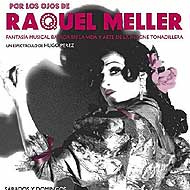 A stage musical
|
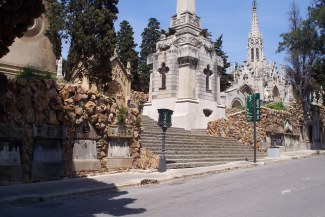 The majestic Montjuic cemetery in Barcelona where the great Raquel Meller rests peacefully.
|
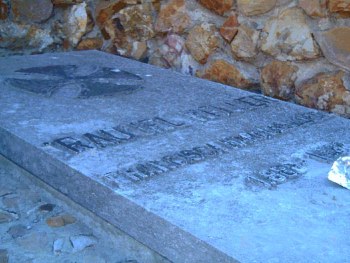 |
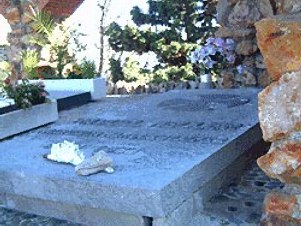 Raquel’s grave
|
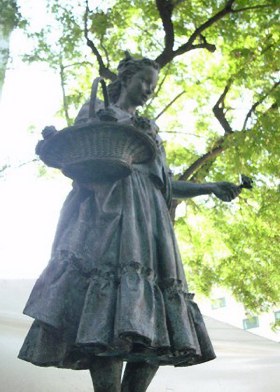 Raquel sculpture in Barcelona's theater district
|
Doubtless, Raquel Meller has not been forgotten and it seems her impact will be felt for many years to come. Besides her significance in music, there is also her legendary life, and the everlasting appeal of her glamorous image.
She remains forever a symbol of talent and beauty, but also of personality, hard work and stedfast determination. A woman of humble origins who came from nowhere and achieved worldwide respect, renown and eventually immortality.
Rest in peace, dear Raquel...
|
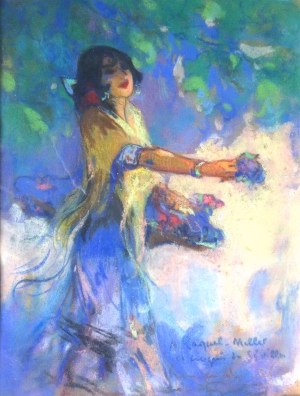 (Painting by Louis Fortuney)
|
Playing "FLOR DE TE"
a Raquel Meller hit
written by J. Martínez Abades.
Performed by orchestra conducted by F. Moreno Torroba
|
